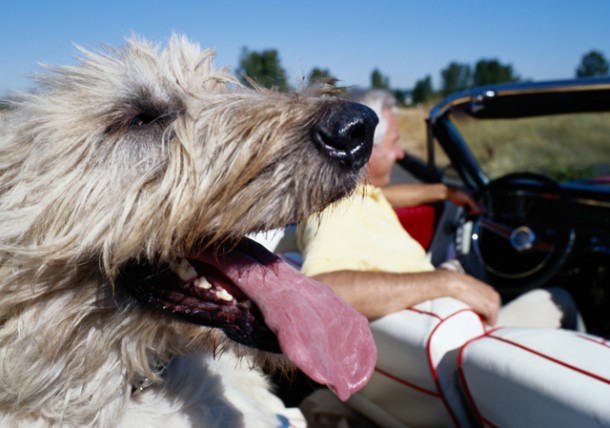Tips for Traveling with Pets

Are you considering taking your pet with you on a trip?
Use the following checklist and remember that it is always better to be prepared for possible situations than to be caught in a crisis without the medications, food, belongings and records that are pertinent to your pet’s well-being.
Medications
Make sure you obtain all medications your pet is currently on, and double-check that you have enough medication so you do not run out while out of town. Realize that it is illegal for a veterinarian to dispense refills or prescribe medications without first examining your pet. You will not be able to simply call a veterinary clinic or present an empty bottle to a veterinarian in order to refill your pet’s medication. If your pet’s medication is compounded, it is especially important to make sure you take enough medication and some extra on your trip.
Food
Take enough of your own pet’s food (and extra) with you. If your pet eats a prescription food, the same restrictions discussed above apply. A veterinarian cannot provide a prescription diet without examining your pet first. Also, as there are many different brands of food, the food your veterinarian carries may not be the same brand of food the local veterinarian at your destination carries in their clinic. It is important to continue to feed the food your pet is used to, as vomiting and diarrhea can occur as a result of an abrupt diet change.
Recent Medical History (within past year)
Call your family veterinarian and get a copy of your pet’s medical records/medications in the past year. Keep these records in an easily accessible binder or envelope in the event that your pet needs medical care while out of town. Include in this list any supplements or holistic medications your pet is currently receiving. Remember that computer and lab systems are not linked together. The veterinarian at your destination does not have access to your family veterinarian’s records. Without recent records, some tests may have to be repeated.
Immunization Records
Updated medical records should include vaccine records, especially the rabies vaccine.
Health CertificatesDocument written by a veterinarian attesting to the health of an animal or group of animals specifically addressing contagious diseases
Health records may be required if you are leaving your home state with your pet. Health records are always required if you are leaving the country with your pet. Be aware of when health certificates need to be completed and what paperwork needs to accompany a health certificate in order to be valid, both for departure and return. Research this information early! If the health certificate has to be completed with a specific timeframe of departure and it is not done, your pet may have to stay home. Call you veterinarian ahead of time and make sure he/she is certified to complete the particular certificate needed. It is not uncommon for international travel that this process needs to be started months in advance.
Update All Identification Information
Make sure ID tags are current and that your pet’s collar fits appropriately. If you pet has a microchip or HomeAgain chip, make sure the contact information is current. If your pet does not have a microchip or HomeAgain chip, consider getting one! These small chips are inserted just under the skin, are painless and ensure that a means of identification always remains with your pet in the event that your pet gets lost and the collar comes off. Chip scanners are universal. These days, almost all veterinary clinics and all shelters have a scanner, and this is the first thing done when someone brings in a stray pet.
Travel Restrictions
If flying with your pet, call the airline ahead of time to check restrictions/regulations. Make sure your pet will not experience extreme temperatures (either hot or cold). Most airlines currently will not allow your pet to be sedated for a trip as sedation can be detrimental to your pet’s health, especially if not traveling in the cabin with you.
Kennel/Bedding/Toys
Take your pet’s kennel and other belongings that they are accustomed to having at home. If your pet is kennel-trained or sleeps in his kennel, bringing a piece of home can be calming for your pet. Keep in mind that if you are meeting up with family members at your destination who also have pets or small children, your pet may not be used to these new people/pets, and brief periods of confinement in his “house” can be beneficial and relaxing for all parties.
Seat Belts/Restraint in car
Your pet is at risk for injury if he/she is allowed to freely roam in the car while moving. If you have to suddenly brake or change lanes, your pet can be thrown or fall from the seat and be injured. If you are in an accident, your pet could be thrown from the car and critically injured. The safest place for your pet is in a kennel or harnessed with a seat belt.
Rest Stops
Give your pet plenty of chances to stop, get out of the car, walk around and use the bathroom. Keep your pet on a leash during rest stops.
Emergency Clinics
Research the phone number and location of emergency veterinary clinics along the way and also at your destination. Call the clinics before you leave to verify location and hours of operation. Keep this information easily accessible during your trip.
Spend some time preparing your pet for their trip to ensure a stress-free, healthy trip for everyone. Careful prior planning can prevent the majority of issues pet owners commonly experience when out of town.
Dr. Christine New practices veterinary medicine at the Hillside Veterinary Clinic in Dallas.

